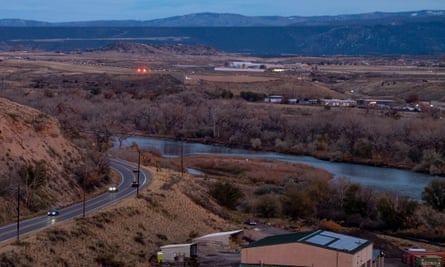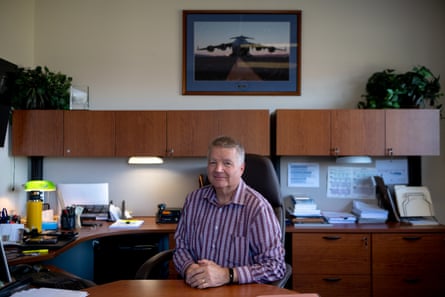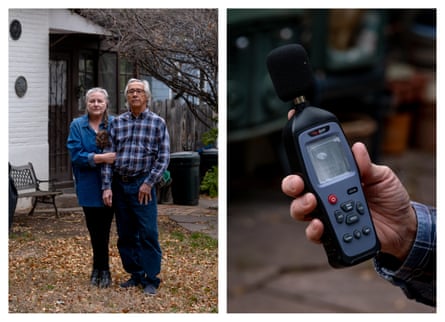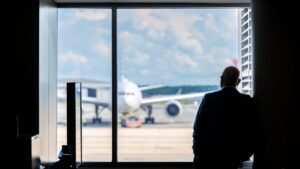IIt was just before noon on New Year’s Day when PJ Breslin reached her limit. As she furiously typed out a letter to the editor of the local paper, the roar of yet another jet plane drowned out her thoughts and rattled the windows of her home office.
“It’s insane to even think that many private jets fly to one small place!” wrote Breslin, who lived in the western Colorado town of Rifle for over 25 years. “Jets owned by the rich, entitled third-home owners and bogus environmentalists, who have no idea of their impact on the valley and the planet, much less their neighbors. They don’t care either.”
Private jet traffic at Rifle Garfield County Airport, a public-use airport located three hours west of Denver, has increased nearly 73% over the past five years, according to a data analysis conducted by the Guardian. The surge is part of a national trend, fueled in part by wealthy travelers ditching commercial flights for private flights in hopes of dodging Covid restrictions, airport crowds and travel delays.
But the majority of people who fly into Rifle don’t stay. Instead, travelers fly quickly to nearby mountain resort destinations like Aspen or Vail in private rental cars, helicopters and limousines.

Brian Condie, the airport manager of nearly 21 years who also sits on the Rifle City Council as the city’s mayor pro tem, said he doesn’t mind travelers not staying in the city of Rifle as long as the airport brings in money . “It continues to be an economic generator for Garfield County.”
But residents like Breslin said they don’t see direct economic benefits. Rather, she feels that the working-class people of Rifle – who cannot afford to charter a private jet – are subsidizing the lavish lifestyles of the wealthy while bearing the brunt of the noise and environmental impacts.
The dynamic, playing out across Colorado and the nation, has been the focus of much of Dr. Amber Woodburn McNair’s research. She is an assistant professor of city and regional planning at The Ohio State University and an affiliate of OSU’s Center for Aviation Studies. Tensions are heightened by the fact that much of the decision-making power related to airports rests in the hands of the US Department of Transportation’s Federal Aviation Administration – and a leading priority is keeping the skies open for business.
“The default position of the FAA is to try to accommodate – safely – so much operations and so much aviation growth [as] the market dictates,” said Woodburn McNair.
This, she said, raises environmental justice concerns.
“Who is asked to bear the noise, the air quality, the traffic impacts that may be there, the contribution to climate change,” she added. “Whose community is asked to bear all this?”
An environmental nightmare
When Rifle Airport opened in 1925, it was mainly used by farmers dusting their nearby fields. Today, the airport has a very different clientele. To fly in or out of the airport, a pilot must book a private charter flight, which can cost between $10,000 and $47,000 round trip. Or they have to own or lease their own aircraft, the cost of which can vary greatly; a small hobby plane can cost around $15,000 while the bill for a private jet can run into the tens of millions.
Its popularity among pilots and high-end travelers is due to a few reasons. The runway is considered safer by pilots than the nearby Aspen/Pitkin County Airport, and there are also no commercial security requirements or noise restrictions. General aviation traffic to Aspen and Eagle is often diverted to Rifle on heavy traffic days or during poor weather conditions.
And unlike Aspen, Rifle has no curfew, meaning passengers can fly in or out at any hour, day or night.
Under current rules, annual operations at the Rifle airport are allowed to more than double, according to Condie. The airport is developing another 69 hectares – which has attracted the attention of private equity firms looking to buy aircraft hangars as real estate investments.

Jeff Posey, the CEO of Genesis Energy Ventures, a private equity firm, and owner of Rifle Aviation LLC, built two hangars at Rifle Airport last year for $3.6 million to capture overflow traffic from Aspen and Vail airports, and to keep track of the growing demand for hangars across the country. He stores two of his own jets in his hangar at Rifle Airport, and also rents out the space – which includes a private pilot’s lounge – to other pilots for a daily fee.
“Our hangar has doubled in price in less than a year because you simply can’t find hangars,” said Posey, whose business is registered with the address of a multimillion-dollar horse farm in the nearby town of Basalt.
Posey has been approved to open a helicopter charter service at the airport that will transport people landing in Rifle to Aspen. There is also talk of opening a flight school or accepting commercial flights – both of which would increase traffic and likely increase noise complaints.
“It’s an exciting time for Rifle, for the growth of the area,” said Posey, who lives in Aspen. “There are going to be people who complain about the traffic. I understand that. I do. But that’s just part of it.”
Other hangar operators at Rifle Airport include two real estate developers, two attorneys and a natural resources consultant — the majority of whom work out of Aspen.
“The people who buy and store jets in Rifle are not the same people who live here. That’s for sure,” said Garrick Frontella, a property manager in Rifle who sits on the city’s improvement team advisory board. He would like to see the city receive some sort of compensation for the impact the airport has on residents’ quality of life.
“There has to be something, a tax or a fee,” he said. “We certainly see no benefit.”
A growing body of research shows extensive exposure to aviation noise can lead to increased stress, cognitive disruption in children, sleep interference and higher risks of heart disease – all of which can take years off one’s life. The US Environmental Protection Agency researched the health impacts of noise pollution until 40 years ago, when the office was in charge defunded during President Ronald Reagan’s administration.
For Breslin, the sound of jets drowns out the television and makes it hard to think straight. She has trouble sleeping, and often wakes up in the middle of the night to her bedside table shaking as a jet rumbles above it. In March, she bought a $100 decibel meter to try to prove that the noise levels exceeded the FAA’s limit, which is an average of 65 decibels over 24 hours. She regularly records noise levels reaching above 90 decibels, she said.
Breslin said the growing airport was the tipping point in what she described as a “deteriorating environmental nightmare”.

She and her husband moved to Rifle in 1997 from Glenwood Springs, another Aspen bedroom community. They opened a small business that helps homeowners install alternative energy systems such as solar panels and water filters that remove environmental toxins.
In recent years, they have spoken out about other environmental concerns in the area, speaking at public meetings and writing letters to elected officials. Their home is by the railroad, which was recently approved to start to transport crude oil, and the town, which is a hub for oil and gas operations, is located along the heavily traveled I-70 highway corridor. But they said nothing is worse than the sound of jets passing over their house at all times of the night.
Condie, the airport manager, lives in town and regularly has planes flying over his house. He says the sound doesn’t bother him. “All I hear is money,” he joked, before pointing to what he sees as the economic benefits. The Rifle airport would support an estimated 277 jobs and $40.95 million in business revenue, according to the state’s 2020 Airport Economic Impact Report. The analysis is based in part on data collected and reported by Condie and other airport staff.
“Is it money in residents’ pockets? No. But if there’s a wildfire in the valley, those planes come from here,” Condie said. “So everyone in Rifle benefits.”
‘We have no way out’
Even before the pandemic, communities across Colorado – and the country – urged local governments and the FAA to impose more regulations on airport activities to limit noise, air pollution and lead exposure. But many local efforts have stalled because the FAA views efforts to regulate air traffic at the local level as inconsistent with its mission.
“You can’t limit the airport,” John Bauer, the FAA’s northwest mountain region manager, said at a public meeting in Aspen in February. “You can’t say, ‘Well, we’re going to limit growth to X. You can’t say, ‘We don’t want this particular plane, but we want this particular one.’
Federal regulation encourages average noise levels at local airports to be measured approximately every 10 years. But monitoring is often rare, according to Woodburn McNair, or non-existent as is the case in Rifle. (There has never been a noise study done at Rifle Airport, according to Condie.) The FAA recently solicited public input on its noise policiesand examine whether it should consider community annoyance and health impacts associated with aviation noise when setting limits.
Meanwhile, local residents say they don’t have much to go to. They can call the airport to complain — or file a formal complaint with the FAA, which often redirects complaints to airport managers. At one time, Rifle residents could bring complaints to an airport authority, but it was disbanded in 1999. Now all day-to-day operations are managed by Condie.

Meanwhile, a potential runway expansion at Aspen’s airport could lead to even more flight traffic in Rifle. Aspen’s 12-person airport advisory board has been around for years debated extending its runway to allow larger planes to land — a step required by the FAA to continue receiving federal funding. The discussion has drawn fierce backlash from some Aspen residents who don’t want to see more visitors and increased noise and air pollution in their backyards.
Amory Lovins, a world famous physicist and president of the non-profit Aspen Fly Right, who opposes the expansion, told the Guardian that the expansion would disrupt local efforts to “maintain community character and quality of life” in the affluent mountain town where the average home price is $2.9 million. One solution, Lovins suggests, would be to divert more of Aspen’s non-commercial traffic to Rifle. He is sympathetic towards residents like Breslin who already bear the brunt of Aspen’s multimillion-dollar tourist economy. But given Rifle’s ability to grow and its safer runway, he sees that as the lesser of two evils. “It’s going to provide them with a lot of economic opportunity,” he said. “It’s very attractive.”
Breslin said this is just another example of Aspen “dumping” their trash in Rifle.
“We are the sacrifice zone in this valley,” Breslin said. “We always have been.”
Coin Master Free Spins Farming: Tips for Success
Unlimited Avacoins in Avakin Life: Myth or Reality?
The Secret Formula for Credits Generation in Bingo Blitz
How to Get TikTok Coins Legally and Quickly
Aprovechando al Máximo los Regalos de Monedas TikTok
Demystifying Free Coins Farming in LivU Video Chat
Coin Master Free Spin Generator Insights: Truth vs. Fiction
Mastering Avacoins in Avakin Life: Expert Insights
Bingo Blitz Credits Generator Insights: Truth vs. Fiction
Coin Master Spin Generator Risks: The Truth
genshin impact codes free primogems and mora for july pc gamer
Are ZEPETO Zems Generators Worth Trying?
match masters free coins archives smartphoneprice com
Maximize Your TikTok Earnings with Free Coins
Free Gems in Brawl Stars: The Future of Brawl Gaming
easy working free dragon city gems generator
family island hack free rubies on android ios 2023
pdf hay day free diamonds online generator hay day hack cheats
litmatch make new friends mod apk 3 8 9 8 happymod apk baixar
myths of moonrise codes 2023 january updated ucn game
home pin how to loot v3 8 8 mod apk unlimited coins
evony mod apk 2023 v4 39 0 unlimited money and gems
dice dreams free rolls collect daily gifts and rewards
project makeover hack codes cheat engine
beach buggy racing 2 hack cheats crates gems gold power ups




